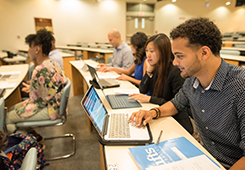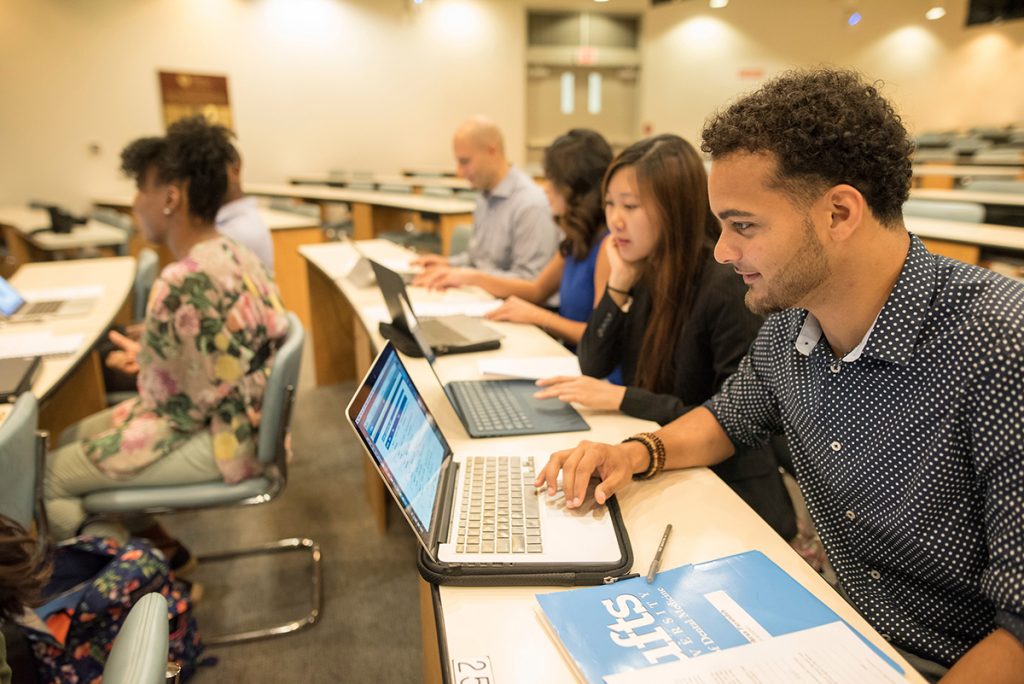
Taking Notes: is the pen mightier than the keyboard? It depends!

By Carie Cardamone, PhD, Associate Director of STEM & Professional Schools, Center for the Enhancement of Learning and Teaching
“Experts—or those who have deconstructed what experts do—take notes. Novices don’t see the point.” – Ben Casnocha
Many students assume that laptops will be their primary note-taking and coursework tool. With a laptop, a student can organize all course materials in one place, including images, syllabi, calendars and instructor notes, and annotate diagrams or instructor PPT slides. Moreover, typing is a faster way to record written words and typically is the dominant format for a student’s written communications. However, faculty frequently raise questions about the impact using a laptop has on student learning. Additionally, numerous studies of note-taking on laptops in classrooms have revealed ways in which the use of laptops alter student learning.
Laptops lead to multitasking, which decreases learning
Regardless of their best intentions, students frequently browse non-course-related material when using laptops in a classroom. This multitasking results in lost learning as divided attention is much worse for memory and comprehension than a multitasker may realize. Even after a brief distraction, the mental consequences of switching tasks last for several minutes. Moreover, the multitasking activities of a single student impacts those seated around them, cascading into a “cone of distraction”. Therefore, the presence of laptops in the classroom can have detrimental repercussions on classroom learning unless the instructor consciously uses strategies to engage students through interactivity, helps students understand and avoid the dangers of multitasking and educates them in the benefits of taking notes by hand whenever possible.
Writing notes by hand can deepen learning & memory
Students often feel that using a laptop to take notes is more effective, because when typing they can record a lecture verbatim. This may lead to notes that are more comprehensive and exhaustive than those written out by hand, but note-taking in this way does not help the student to identify key points and synthesize the information – i.e., learn! In contrast, when taking notes by hand, students frequently process what they are hearing more deeply as they are forced to decide what to write. Students also process visual information when they describe what is presented in an image through written words. They use spatial reasoning through sketches and the way they layout information to encode ideas on a page. This commonly leads to higher performance of those who are taking notes by hand on conceptual questions, particularly when they are provided with the opportunity to review their notes. Several comparative studies have also documented decreased learning among students with open laptops, and have shown that positive learning increases in classrooms where laptops were not used by students for note-taking.
Implications for the classroom
Nearly all students use a laptop or similar devices, and these tools now occupy a central role in their learning. During a class, laptops can be used for taking notes, accessing information and resources, group work collaboration or interacting with computational tools and simulations. The effectiveness of the use of laptops is tied to the modality of the teaching environment and the learning activities of the student. While some faculty have considered banning laptops from their classroom, this raises concerns about accessibility, as some students require laptops for assistive technology and academic accommodations. Restricting laptop use for everyone except those who require them, publicly identifies individuals who need accommodations, which removes their right to privacy.
In response to these concerns, faculty have adopted a range of policies regarding the use of technology in their classroom. These can vary based on the student population, classroom layout, and an individual faculty member’s philosophy. Faculty have also held discussions with their students about the use of laptops in the classroom as a way to help students develop learning strategies. As you decide what policies you’d like to adopt for your own classroom, consider reflecting on the suggested questions below.
Questions to consider for your classroom:
When and in what ways might a laptop or device be useful for students’ participation in course activities?
- Are there times when a student should be searching for information or viewing course resources?
- Is there a diagram or PowerPoint slide that would be helpful for students to annotate?
- When are students prompted to synthesize rather than record information – e.g., summarizing key points or responding to conceptual questions?
- How might laptops help students share their ideas and notes with each other?
How might the use of laptops impact other students in the classroom?
- Does the use of laptops change expectations of privacy in discussions around sensitive topics?
- Are there specific areas of a classroom where students using laptops for note-taking can sit to minimize distractions for their peers? For example, are their side sections in a large lecture hall?
What class policies do you want to set and how will you communicate them with your students?
- What will you communicate through your syllabus and in the beginning of the semester? How might the tone of your policy impact your students?
- How transparent will you make your reasoning to your students?
- Do you wish to include students in the decision-making process or creation of a shared laptop policy?
- What are the implications of a complete ban for students with accessibility needs?
So is the pen mightier than the laptop? It’s really all about the students’ learning experience!
Further Reading:
Enough With the Laptop Ban Debate! from Inside Higher Ed, Dec 2017
Laptops Are Great. But Not During a Lecture or a Meeting – A faculty members perspective by Susan Dynarski in the NYTimes, Nov 2017
The science of multitasking, and why you should doodle in class – Dr Jim Davies from Carleton University summarizes the research from cognitive psychology on multitasking, Sept. 2018
References
- Carter, S. P., Greenberg, K., & Walker, M. S. (2017). The impact of computer usage on academic performance: Evidence from a randomized trial at the United States Military Academy. Economics of Education Review, 56, 118-132.
- Hembrooke, H., & Gay, G. (2003). The laptop and the lecture: The effects of multitasking in learning environments. Journal of Computing in Higher Education, 15(1), 46–64.
- Kraushaar, J. M., & Novak, D. C. (2010). Examining the affects of student multitasking with laptops during the lecture. Journal of Information Systems Education, 21(2), 241.
- Luo, L., Kiewra, K. A., Flanigan, A. E., & Peteranetz, M. S. (2018). Laptop versus longhand note taking: effects on lecture notes and achievement. Instructional Science, 1-25.
- Morehead, Kayla, John Dunlosky, and Katherine A. Rawson. “How Much Mightier Is the Pen than the Keyboard for Note-Taking? A Replication and Extension of Mueller and Oppenheimer (2014).” Educational Psychology Review, February 4, 2019.
- Mueller, P. A., & Oppenheimer, D. M. (2014). The pen is mightier than the keyboard: Advantages of longhand over laptop note taking. Psychological science, 25(6), 1159-1168.
- Patterson, R. W., & Patterson, R. M. (2017). Computers and productivity: Evidence from laptop use in the college classroom. Economics of Education Review, 57, 66–79.
- Ravizza, S. M., Uitvlugt, M. G., & Fenn, K. M. (2017). Logged in and zoned out: How laptop internet use relates to classroom learning. Psychological science, 28(2), 171-180.
- Sana, F., Weston, T., & Cepeda, N. J. (2013). Laptop multitasking hinders classroom learning for both users and nearby peers. Computers & Education, 62, 24-31.



